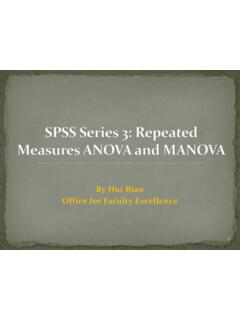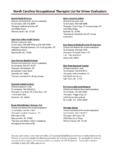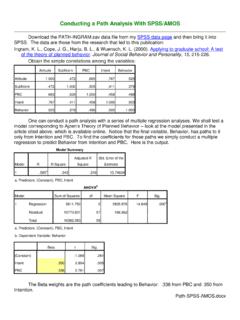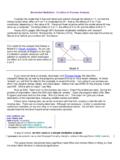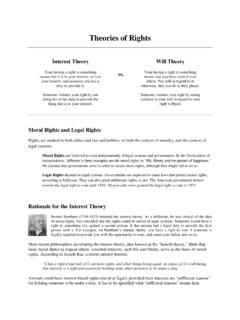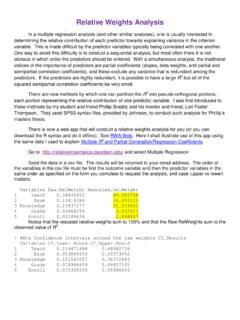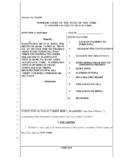Transcription of AN INTRODUCTION TO MULTIVARIATE STATISTICS
1 An INTRODUCTION to MULTIVARIATE STATISTICS The term MULTIVARIATE STATISTICS is appropriately used to include all STATISTICS where there are more than two variables simultaneously analyzed. You are already familiar with bivariate STATISTICS such as the Pearson product moment correlation coefficient and the independent groups t-test. A one-way ANOVA with 3 or more treatment groups might also be considered a bivariate design, since there are two variables: one independent variable and one dependent variable. Statistically, one could consider the one-way ANOVA as either a bivariate curvilinear regression or as a multiple regression with the K level categorical independent variable dummy coded into K-1 dichotomous variables.
2 Independent vs. Dependent Variables We shall generally continue to make use of the terms independent variable and dependent variable, but shall find the distinction between the two somewhat blurred in MULTIVARIATE designs, especially those observational rather than experimental in nature. Classically, the independent variable is that which is manipulated by the researcher. With such control, accompanied by control of extraneous variables through means such as random assignment of subjects to the conditions, one may interpret the correlation between the dependent variable and the independent variable as resulting from a cause-effect relationship from independent (cause) to dependent (effect) variable.
3 Whether the data were collected by experimental or observational means is NOT a consideration in the choice of an analytic tool. Data from an experimental design can be analyzed with either an ANOVA or a regression analysis (the former being a special case of the latter) and the results interpreted as representing a cause-effect relationship regardless of which statistic was employed. Likewise, observational data may be analyzed with either an ANOVA or a regression analysis, and the results cannot be unambiguously interpreted with respect to causal relationship in either case. We may sometimes find it more reasonable to refer to independent variables as predictors , and dependent variables as response-, outcome-, or criterion-variables.
4 For example, we may use SAT scores and high school GPA as predictor variables when predicting college GPA, even though we wouldn t want to say that SAT causes college GPA. In general, the independent variable is that which one considers the causal variable, the prior variable (temporally prior or just theoretically prior), or the variable on which one has data from which to make predictions. Descriptive vs. Inferential STATISTICS While psychologists generally think of MULTIVARIATE STATISTICS in terms of making inferences from a sample to the population from which that sample was randomly or representatively drawn, sometimes it may be more reasonable to consider the data that one has as the entire population of interest.
5 In this case, one may employ MULTIVARIATE descriptive STATISTICS (for example, a multiple regression to see how well a linear model fits the data) without worrying about any of the assumptions (such as homoscedasticity and normality of conditionals or residuals) associated with inferential STATISTICS . That is, MULTIVARIATE STATISTICS , such as R2, can be used as descriptive STATISTICS . In any case, psychologists rarely ever randomly sample from some population specified a priori, but often take a sample of convenience and then generalize the results to some abstract population from which the sample could have been randomly drawn. Rank-Data I have mentioned the assumption of normality common to parametric inferential STATISTICS .
6 Please note that ordinal data may be normally distributed and interval data may not, so scale of measurement is irrelevant. Rank-ordinal data will, however, be non-normally distributed (rectangular), so one might be concerned about the robustness of a statistic s normality assumption with rectangular data. Although this is a Copyright 2016 Karl L. Wuensch - All rights reserved. 2 controversial issue, I am moderately comfortable with rank data when there are twenty to thirty or more ranks in the sample (or in each group within the total sample). Why (and Why Not) Should One Use MULTIVARIATE STATISTICS ? One might object that psychologists got along OK for years without MULTIVARIATE STATISTICS .
7 Why the sudden surge of interest in MULTIVARIATE stats? Is it just another fad? Maybe it is. There certainly do remain questions that can be well answered with simpler STATISTICS , especially if the data were experimentally generated under controlled conditions. But many interesting research questions are so complex that they demand MULTIVARIATE models and MULTIVARIATE STATISTICS . And with the greatly increased availability of high speed computers and MULTIVARIATE software, these questions can now be approached by many users via MULTIVARIATE techniques formerly available only to very few. There is also an increased interest recently with observational and quasi-experimental research methods. Some argue that MULTIVARIATE analyses, such as ANCOV and multiple regression, can be used to provide statistical control of extraneous variables.
8 While I opine that statistical control is a poor substitute for a good experimental design, in some situations it may be the only reasonable solution. Sometimes data arrive before the research is designed, sometimes experimental or laboratory control is unethical or prohibitively expensive, and sometimes somebody else was just plain sloppy in collecting data from which you still hope to distill some extract of truth. But there is danger in all this. It often seems much too easy to find whatever you wish to find in any data using various MULTIVARIATE fishing trips. Even within one general type of MULTIVARIATE analysis, such as multiple regression or factor analysis, there may be such a variety of ways to go that two analyzers may easily reach quite different conclusions when independently analyzing the same data.
9 And one analyzer may select the means that maximize e s chances of finding what e wants to find or e may analyze the data many different ways and choose to report only that analysis that seems to support e s a priori expectations (which may be no more specific than a desire to find something significant, that is, publishable). Bias against the null hypothesis is very great. It is relatively easy to learn how to get a computer to do MULTIVARIATE analysis. It is not so easy correctly to interpret the output of MULTIVARIATE software packages. Many users doubtlessly misinterpret such output, and many consumers (readers of research reports) are being fed misinformation. I hope to make each of you a more critical consumer of MULTIVARIATE research and a novice producer of such.
10 I fully recognize that our computer can produce MULTIVARIATE analyses that cannot be interpreted even by very sophisticated persons. Our perceptual world is three dimensional, and many of us are more comfortable in two dimensional space. MULTIVARIATE STATISTICS may take us into hyperspace, a space quite different from that in which our brains (and thus our cognitive faculties) evolved. Categorical Variables and LOG LINEAR ANALYSIS We shall consider MULTIVARIATE extensions of STATISTICS for designs where we treat all of the variables as categorical. You are already familiar with the bivariate (two-way) Pearson Chi-square analysis of contingency tables. One can expand this analysis into 3 dimensional space and beyond, but the log-linear model covered in Chapter 17 of Howell is usually used for such MULTIVARIATE analysis of categorical data.
